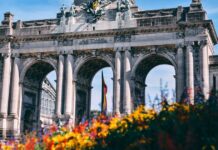Trump’s border czar says Canadian border is an ‘extreme’ vulnerability
U.S. president-elect Donald Trump’s border czar says there is an “extreme national security vulnerability” along the Canada-U.S. border that he plans to deal with the moment the new Republican administration takes power.
Tom Homan, named Sunday as the official in charge of all U.S. border issues, said in a television interview that he expects there will be “tough conversations” with Ottawa about the situation along the Canada-U.S. border.
“The problem with the northern border is a huge national security issue,” Homan told 7News in Watertown, N.Y., a community some 40 kilometres from a crossing into eastern Ontario. Homan is from the area.
He said “special interest aliens” — individuals from countries the U.S. says sponsor terror — use Canada as a gateway into the U.S.
“Because they know, [there’s] a lot less, fewer officers here,” Homan said. “It’s one of the things I’ll tackle when I’m in the White House.”
In raw numbers, irregular crossings along the U.S. border with Mexico substantially outpace those over the Canadian border. However, human smuggling activity from Canada has risen sharply over the past two years, particularly along the border between eastern Ontario, Quebec, New York and Vermont.

U.S. Border Patrol (USBP) agents apprehended over 19,000 individuals, from 97 different countries, through this area over a 12-month span ending Oct. 2, according to U.S. Customs and Border Protection statistics.
That’s more than were apprehended throughout the same area over the previous 17 fiscal years combined, according to a recent post on X by the USBP’s Chief Patrol Agent Robert Garcia, who is in charge of the region, which is known as the Swanton Sector.
This has created friction with U.S. officials along border areas and their concerns were picked up by Trump during the election campaign and by his former Republican challengers Nikki Haley and Vivek Ramaswamy during the primary race.
Knows the region
Homan comes from West Carthage, N.Y., which sits about 70 kilometres southeast of Ontario’s Thousand Islands region on the St. Lawrence River.
“It’s home, I’m not going to ignore home,” he told 7News.
Homan, a former acting director for Immigration and Customs Enforcement, said he will be working in the White House and reporting directly to Trump while overseeing the new administration’s plans for border crackdowns and mass deportations.
Trump, Homan said, must work with Prime Minister Justin Trudeau to see that Canada’s immigration laws are enforced.

“There has to be an understanding from Canada that they can’t be a gateway to terrorists coming into the United States,” he said.
Gabriel Brunet, a spokesperson for Public Safety Minister Dominic LeBlanc, said in an emailed statement that the two countries have a “shared interest in deepening collaboration on cross-border issues.” The statement said Canadian law enforcement agencies “are working day in and day out, with their U.S. counterparts” to maintain the integrity of the border.
LeBlanc “looks forward to building a constructive and positive relationship with whomever President Trump selects as his or her Secretary of Homeland Security,” said the statement. Trump said Tuesday his nominee for that job is South Dakota Gov. Kristi Noem.
U.S. pressure over irregular border crossings played a role in Canada’s decision this past winter to reimpose some visa requirements on Mexican nationals entering the country. At the time, Mexican nationals were one of the biggest drivers behind the rising numbers of irregular crossings into New York state and Vermont.
U.S. data now places India as the top source country for irregular crossings from Canada.
In an interview with Catherine Cullen, host of CBC Radio’s The House, Deputy Prime Minister and Finance Minister Chrystia Freeland said her message to the rest of the world is that Canada welcomes newcomers in an ‘organized, systematic way.’
Tom Kmiec, the Conservative party’s critic on the immigration, refugee and citizenship file, says the Liberals made an “error” in 2016 when they removed visa requirements from Mexican nationals and then “slow walked” the reversal. The previous Conservative government of Stephen Harper initially put the visa requirements in place.
Kmiec also referred to the recent cases involving an Egyptian-born father and son duo and a Pakistani student arrested in Canada for allegedly planning separate ISIS-linked attacks in Toronto and New York City. The student was allegedly planning to enter the U.S. with the help of human smugglers.
“On border security and visa integrity, the Liberals just aren’t worth the cost,” Kmiec said in a statement.
A deadly business
Human smuggling in Canada is a lucrative business, with some organized crime groups charging between $1,500 to $6,000 US per person for trips that often begin in Toronto or Montreal, then head through borderland areas of rivers, farmlands and forests.
Some journeys turn fatal. This past December, Ana Karen Vasquez-Flores, a 33-year-old pregnant Mexican woman, was found dead near Champlain, N.Y., after crossing from Canada.
The RCMP announced in June it had taken down an international smuggling ring allegedly connected to the St. Lawrence River drowning deaths of two families — one from India and the other from Romania — in March 2023. Both families were being smuggled into the U.S.
Published at Fri, 01 Nov 2024 08:11:21 +0000
Palestinian paramedic recounts ‘massacre’ on school shelter in northern Gaza
WARNING: The story contains graphic details of wounded children and people.
As one of the few paramedics left in northern Gaza, Niveen Al-Dwawsa, 21, is often one of the first on the scene in the aftermath of an airstrike, running to help as many wounded people as she can. Even though there are few resources left in the region, she feels she can’t abandon those left behind.
When she responded to an airstrike in Jabalia on Oct. 21, Al-Dwawsa found herself surrounded by wounded people, as well as the bodies of men, women and children in the yard of a former school being used as a shelter in the northern section of the Gaza Strip. The area has been subject to more than a month-long Israeli ground invasion that has not allowed in aid or food, according to residents, and forcibly displaced most of the Palestinians living there.
That day, Al-Dwawsa used her phone to frantically film the horror she saw unfolding.
“It was a massacre, we were living in a horror story,” Al-Dwawsa told CBC News on Nov. 3, from Al-Helou International Hospital in northwest Gaza City where she was visiting children wounded in the attack that killed at least 20 people and left 40 wounded, according to health officials.
Warning: This video shows blurred images of dead and injured people, including children. Paramedic Niveen Al-Dwawsa describes her experience recording the aftermath of a deadly Israeli airstrike on Jabalia Boys Elementary school on Oct. 21 in northern Gaza.
“There were so many children with their limbs torn off,” she said. “Or their intestines were hanging outside their stomach.”
Al-Dwawsa says displaced people at the Jabalia Boys Elementary school were under “siege” by Israeli troops for about 16 or 17 days before the deadly attack and were not able to get food or aid during that time. She says that right before the airstrike, the Israeli army used quadcopters with speakers to tell people they had one hour to evacuate the area.
According to Al-Dwawsa, the school was attacked just 10 minutes later.
As she watched the video she recorded of the aftermath, she described the panic, horror and helplessness she felt while running from body to body, trying to save those who were still alive.

In the video, Al-Dwaswa can be heard yelling for an uncle. “They killed him, Uncle Abu Mohamed,” she shouts, still recording even as she walks through the bloody scene, reacting to all the wounded and dying people around her.
The video also showed children on the street covered in blood, some of their body parts pointing in opposite directions. She says some of the children begged her to help the wounded.
“The situation was truly very difficult.”
Al-Dwawsa comes to a section of the video that shows a child’s body, completely covered in blood, slumped over. “That is Alma, the sister of the children I came here to check on here at this hospital.”
The Hamas-led militant attacks on Oct. 7, 2023, killed some 1,200 people and saw 251 people taken hostage to Gaza, according to Israeli tallies. Since then, Israel’s retaliatory attacks have killed more than 43,500 Palestinians and left over 102,600 wounded, local health authorities say.
The UN Human Rights Office said last week that nearly 70 per cent of the fatalities it has verified for the first six months of the Gaza war were women and children. The UN condemned what it called a systematic violation of the fundamental principles of international humanitarian law.
Medics working with few resources
Al-Dwawsa says some people she saw at the site of the attack were “bleeding out for more than two hours.” She says there were two nurses and a doctor at the school, but she was the only paramedic on the scene.
CBC News reached out to the Gaza Ministry of Health to ask about the number of medical staff remaining in the north but did not get a response in time for publication.
She says she refused to evacuate the area until she helped every wounded person out of the school, found the bodies of those killed and eventually helped bury them.
A few days following the attack, Palestinian Civil Defence, the agency that carries out first responder and search and rescue services in the enclave, announced it would pull out of northern Gaza. It said its volunteer crews have been targeted by Israeli attacks in the area.
Al-Dwawsa says medical staff like herself have been forced to work under increasingly difficult if not impossible circumstances without access to medical supplies or even ambulances to move them in.
“I, as a paramedic, cannot rescue more than 30 or 40 wounded or care for 10 or 20 martyrs in these situations,” she said.
“They need ambulances, they need a whole medical department, they need a [functioning] hospital.”
People in northern Gaza were calling for more help on Tuesday after a deadly Israeli airstrike on a building in Beit Lahiya, which witnesses said was sheltering displaced people, including women and children. (Warning: This video contains images showing covered bodies and an injured person.)
Hamas not present at school, paramedic says
In early October, the Israeli army launched a ground offensive in Jabalia, the largest of the enclave’s eight historic refugee camps. Army officials said they were trying to stop Hamas militants from regrouping.
Al-Dwawsa told CBC News that she saw “nobody from Hamas’s side” at the school shelter, only civilians.
“Too many children were martyred, too many orphaned, too many youth are gone,” she said. “Our school is gone, it’s completely destroyed.”
CBC News has reached out to the Israel Defence Forces (IDF), but did not receive a response in time for publication.
Last month, the IDF said it had captured around 100 suspected Hamas militants, including medical staff, during a raid at Kamal Adwan Hospital in Beit Lahiya. Gaza health officials and Hamas have denied that militants were present at the hospital.
Officials with the Palestinian Civil Defence agency said people in those areas have been left “without humanitarian, medical or rescue services” as a result of the attacks.
Leaving her family to treat the injured
When Hamas’s Oct. 7, 2023, attacks on Israel took place, Al-Dwawsa was living and working in Beit Lahiya, where she remained for much of the war. In the aftermath of the school attack, she moved to Gaza City’s Sheikh Radwan neighbourhood, less than two kilometres from Jabalia.
During her time in the north, Al-Dwawsa says she’s spent every day treating and caring for wounded patients. This means she’s been forced to leave her family members, who’ve been displaced at least 10 times.
Since the war began, she says about 70 of her own family members have been killed, including her grandfather, uncles and cousins. Now, she says she has 10 family members who are still alive spread out across south and central Gaza.
“Basically, most of our family was wiped off the civil registry,” she said.

Now, she works for the Palestinian non-governmental organization Juzoor for Health and Social Development, a team of health-care staff working to address the needs of those in Gaza.
Al-Dwawsa says that despite the attacks, she has no plans to leave the north as long as people there still need her help. She says she and the other civilians who are left are “not going to surrender.”
Published at Wed, 13 Nov 2024 09:00:00 +0000










